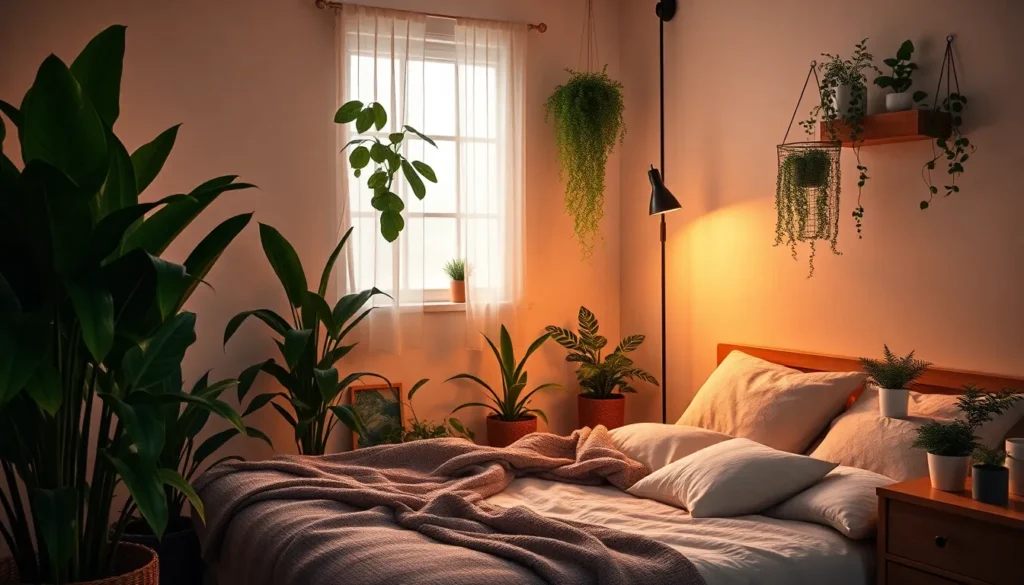Transform your bedroom into a serene sanctuary where nature meets comfort with the perfect blend of greenery and cozy elements. We’ve discovered that adding plants to your bedroom doesn’t just boost air quality – it creates an atmosphere that promotes better sleep and reduces stress levels naturally.
Creating a cozy bedroom with plants is easier than you might think. We’ll show you how strategic plant placement combined with warm textures and soft lighting can turn your space into a peaceful retreat that feels like a luxury spa. From low-maintenance succulents to air-purifying snake plants, there’s a perfect green companion for every bedroom style.
Whether you’re working with a small space or a master suite, we’ve gathered the most effective tips to help you design a plant-filled bedroom that’s both beautiful and functional. You’ll learn which plants thrive in bedroom conditions and how to style them for maximum cozy factor.
Choose the Perfect Plants for Your Cozy Bedroom Environment
Selecting plants that complement your bedroom’s unique environment ensures they’ll flourish while improving your restful space. We’ve identified the most suitable options based on lighting conditions, air quality benefits, and safety considerations.
Low-Light Tolerant Plants That Thrive Indoors
Snake plants excel in bedroom environments with minimal natural light, requiring water only every 2-3 weeks while producing oxygen at night. These architectural beauties grow vertically, making them perfect for corners or beside dressers.
Pothos varieties adapt to nearly any lighting condition, cascading gracefully from hanging planters or shelves above your bed. They’re incredibly forgiving if you forget to water them for a week or two.
ZZ plants store water in their thick stems and glossy leaves, surviving in low light conditions for months with minimal care. Their sculptural appearance adds modern elegance to bedside tables or floor corners.
Peace lilies bloom beautiful white flowers even in dimly lit bedrooms, signaling when they need water by drooping their leaves slightly. We recommend placing them on nightstands where you can easily monitor their needs.
Air-Purifying Plants for Better Sleep Quality
Spider plants remove formaldehyde and xylene from bedroom air while producing baby plantlets you can propagate for other rooms. NASA studies confirm they improve indoor air quality by up to 70% in enclosed spaces.
Rubber trees filter benzene and formaldehyde through their large, waxy leaves while releasing oxygen during nighttime hours. Position them near windows where they can process the most air circulation.
Aloe vera releases oxygen at night while absorbing carbon dioxide, creating an optimal breathing environment for sleep. Keep this succulent on your windowsill where it can also serve as a natural remedy for minor cuts or burns.
Boston ferns increase humidity levels by 10-15% while filtering airborne toxins, making them ideal for dry bedroom environments. Hang them in macrame planters or place them on plant stands for maximum air circulation benefits.
Pet-Safe Plant Options for Bedroom Spaces
Parlor palms bring tropical vibes to cozy bedrooms without posing risks to curious cats or dogs who might nibble on leaves. These slow-growing palms thrive in indirect light and add height to bedroom corners.
Prayer plants fold their colorful leaves at night, creating a natural sleep rhythm that mirrors your own while remaining completely safe for pets. Their striking patterns make them excellent accent pieces on dressers or floating shelves.
Ponytail palms store water in their bulbous trunks, requiring minimal maintenance while staying non-toxic to household animals. We love their whimsical appearance on bedroom windowsills or plant stands.
Bamboo palms create natural room dividers in larger bedrooms while maintaining pet safety and improving air quality simultaneously. Group several together for a spa-like atmosphere that promotes relaxation.
Create Optimal Plant Placement for Maximum Coziness
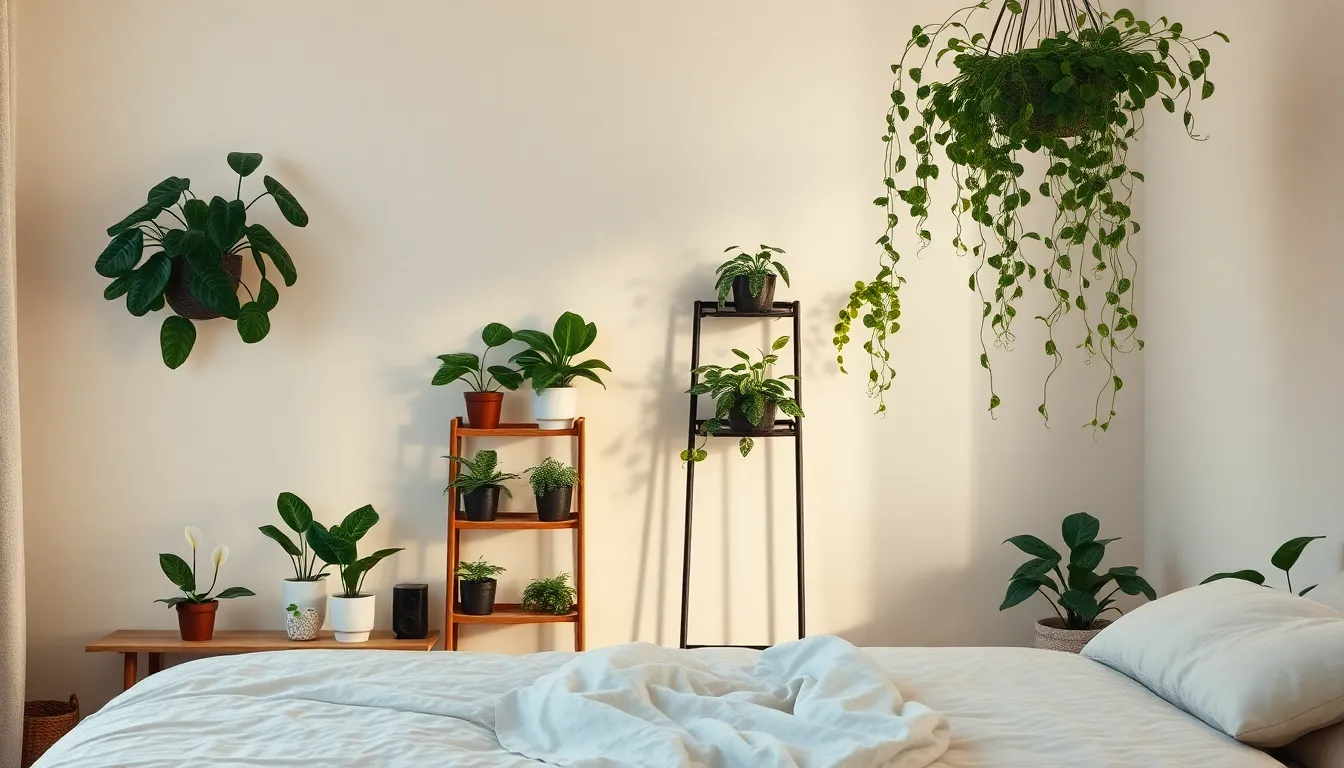
Strategic plant placement transforms your bedroom into a serene sanctuary while maximizing both visual appeal and functional space. We’ll explore three key placement strategies that create the perfect balance of greenery and comfort.
Bedside Table Plant Arrangements
Small to medium plants on bedside tables create an intimate connection with nature right where you sleep. We recommend selecting low maintenance, air purifying plants like snake plants, pothos, or peace lilies that thrive in indoor conditions without demanding constant attention.
Decorative pots should complement your bedroom decor while avoiding overcrowding the essential bedside space. Balance becomes crucial when positioning plants alongside your lamp, books, or charging station to maintain both coziness and functionality.
Choose plants that won’t overwhelm your nighttime routine but still provide that calming green presence as you wind down for sleep. Compact varieties work best since they won’t obstruct your view or interfere with reaching for nighttime essentials.
Corner Plant Displays for Vertical Interest
Corners offer the perfect opportunity for creating lush plant displays using corner plant stands or tiered shelves designed specifically for greenery. These stands come in materials like brass, rattan, metal, or wood to seamlessly match your room’s existing style.
Vertical plant arrangements help maximize underutilized corner space while creating stunning green focal points that add texture and height. We suggest using tiered corner plant stands that range from tall narrow designs to triangular shapes that fit snugly into tight spaces.
Stacking multiple plants vertically creates visual drama without impeding movement through your bedroom or cluttering valuable floor space. This approach works particularly well for displaying a variety of plant sizes and types in one cohesive arrangement.
Hanging Plants to Save Floor Space
Hanging plants excel in bedrooms with limited floor space by adding overhead greenery while preserving open areas below. We recommend using macrame holders or ceiling hooks positioned near windows or corners for optimal plant health and visual appeal.
Trailing plants like philodendrons and spider plants cascade beautifully downward, improving the cozy atmosphere while creating natural curtain effects. These suspended gardens work especially well in smaller bedrooms where every square foot of floor space matters.
Position hanging plants where they’ll receive adequate light without interfering with daily activities like making the bed or moving around the room. This placement strategy adds vertical dimension to your plant collection while maintaining the bedroom’s primary function as a restful retreat.
Select Complementary Planters and Containers
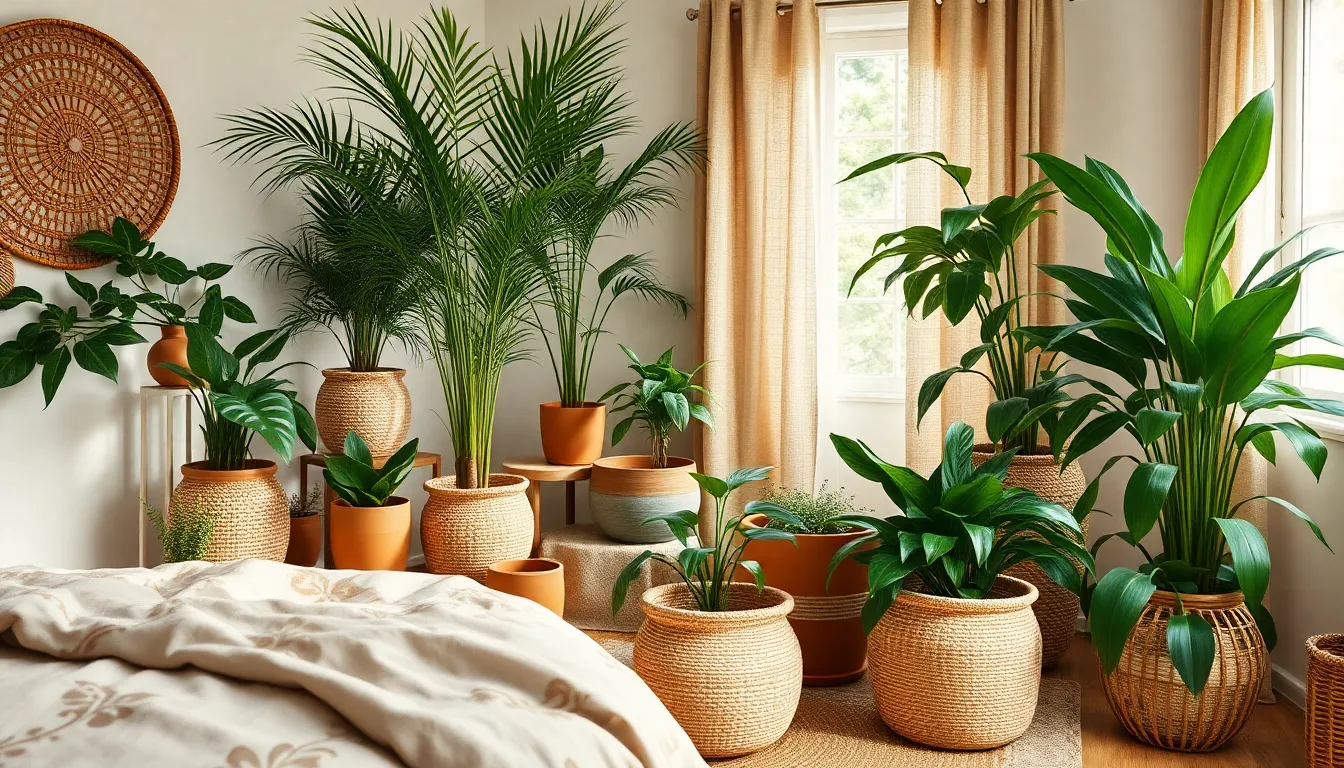
We’ll transform your bedroom’s atmosphere by choosing planters that harmonize with both your plants and decor. The right containers create visual cohesion while supporting your plants’ health and the room’s cozy ambiance.
Natural Materials That Enhance Cozy Vibes
Terracotta pots bring warmth and breathability to your plant display while adding earthy texture. Clay materials naturally regulate moisture and provide a rustic charm that softens modern bedroom aesthetics. Woven baskets offer versatility for larger plants like bamboo palms or snake plants, creating visual interest through their textured surfaces.
Bamboo planters echo nature’s organic lines and complement minimalist bedroom designs beautifully. Wood containers add warmth through their natural grain patterns and pair exceptionally well with floating shelves or bedside table arrangements. Rattan holders create a bohemian vibe that enhances the tranquil atmosphere you’re cultivating.
Color Coordination with Bedroom Decor
Earth tones create seamless integration between your plants and existing bedroom colors. Neutral containers in whites, beiges, and soft grays allow your greenery to shine while maintaining visual harmony. Choose complementary shades that echo your bedding or wall colors for a unified look.
Variegated plants like Philodendron “Birkin” or Hoya “Tricolor” add subtle multi-tonal interest without overwhelming minimalist spaces. Soft pastels work wonderfully with cozy bedroom palettes, creating gentle contrast against leafy greens. Avoid bold or clashing colors that might disrupt the peaceful atmosphere you’re creating.
Size and Scale Considerations for Small Spaces
Small pots on windowsills maximize natural light exposure without cluttering essential surfaces. Bedside tables accommodate compact containers perfectly, keeping your favorite plants within easy reach for daily care. Vertical hanging answers free up floor space while adding visual height to cramped bedrooms.
Floating shelves support multiple small plants without overwhelming narrow spaces or blocking walking paths. Corner placements work best for larger statement plants like fiddle leaf figs, utilizing otherwise unused areas effectively. Strategic positioning ensures your plants enhance rather than crowd your cozy bedroom sanctuary.
Design Plant-Friendly Lighting Solutions
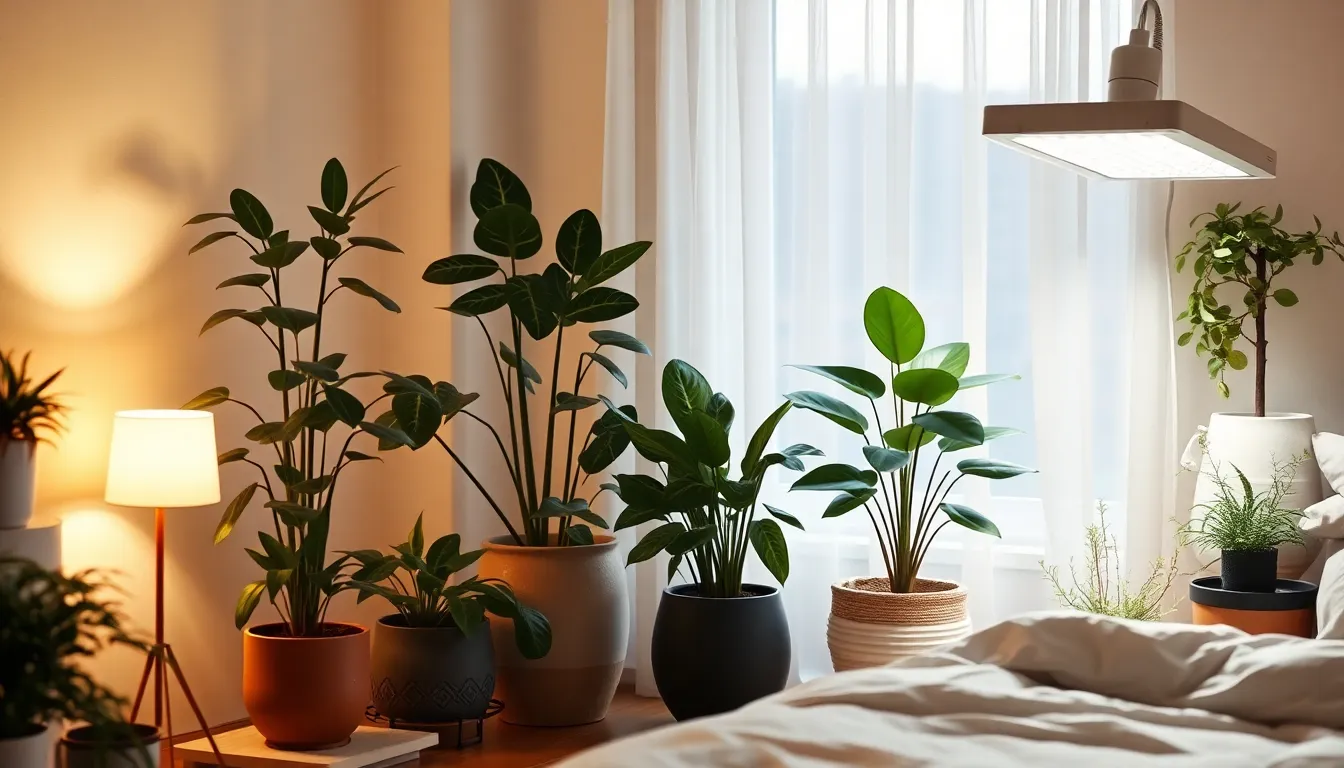
Now that we’ve established the perfect plant placement for our cozy bedroom sanctuary, we need to ensure our green companions receive the right lighting to thrive. Creating effective lighting answers requires balancing plant health needs with the warm ambiance that promotes restful sleep.
Natural Light Optimization Techniques
Positioning plants near windows with bright, indirect sunlight creates the ideal environment for most houseplants like fiddle leaf figs and peace lilies. We can maximize this natural resource by strategically placing our greenery where they’ll receive consistent illumination without harsh direct rays.
Installing sheer curtains helps diffuse direct sunlight while protecting our plants from damaging UV exposure. This approach creates soft, filtered lighting that benefits both room comfort and plant health throughout the day.
Grouping plants with similar lighting requirements streamlines our care routine while creating visually appealing layers. We can arrange sun loving species together near bright windows and shade tolerant varieties in dimmer corners for optimal growth patterns.
Artificial Grow Lights for Dark Bedrooms
LED grow lamps and specialized grow light bulbs integrated into existing fixtures provide subtle plant support in rooms lacking adequate sunlight. These answers maintain our bedroom’s aesthetic while delivering essential light spectrum requirements for healthy plant development.
Positioning grow lights based on individual plant needs ensures optimal growth without overwhelming our space. We should place lights higher for low light plants like snake plants and pothos, while positioning them closer for high light species such as fiddle leaf figs and dwarf citrus.
Automated timers regulate light cycles effectively while maintaining our bedroom’s peaceful ambiance. This technology ensures our plants receive sufficient illumination during appropriate hours without disrupting our sleep schedule or creating unwanted brightness.
Ambient Lighting That Benefits Both Plants and Sleep
Warm toned grow light bulbs emit a cozy glow that supports our circadian rhythms while promoting plant health. These specialized bulbs create the perfect balance between functional plant lighting and relaxing bedroom atmosphere.
Layering ambient lighting with soft bedside lamps and indirect sources prevents harsh brightness that disrupts sleep quality. We can combine decorative grow light fixtures with traditional warm lighting to achieve both plant care goals and restful evening routines.
Wake up light answers enhance our morning mood while providing plant friendly illumination throughout the day. These dual purpose fixtures gradually increase brightness to simulate natural sunrise patterns, benefiting both our sleep wake cycle and our plants’ photosynthetic processes.
Establish Easy Care Routines for Bedroom Plants
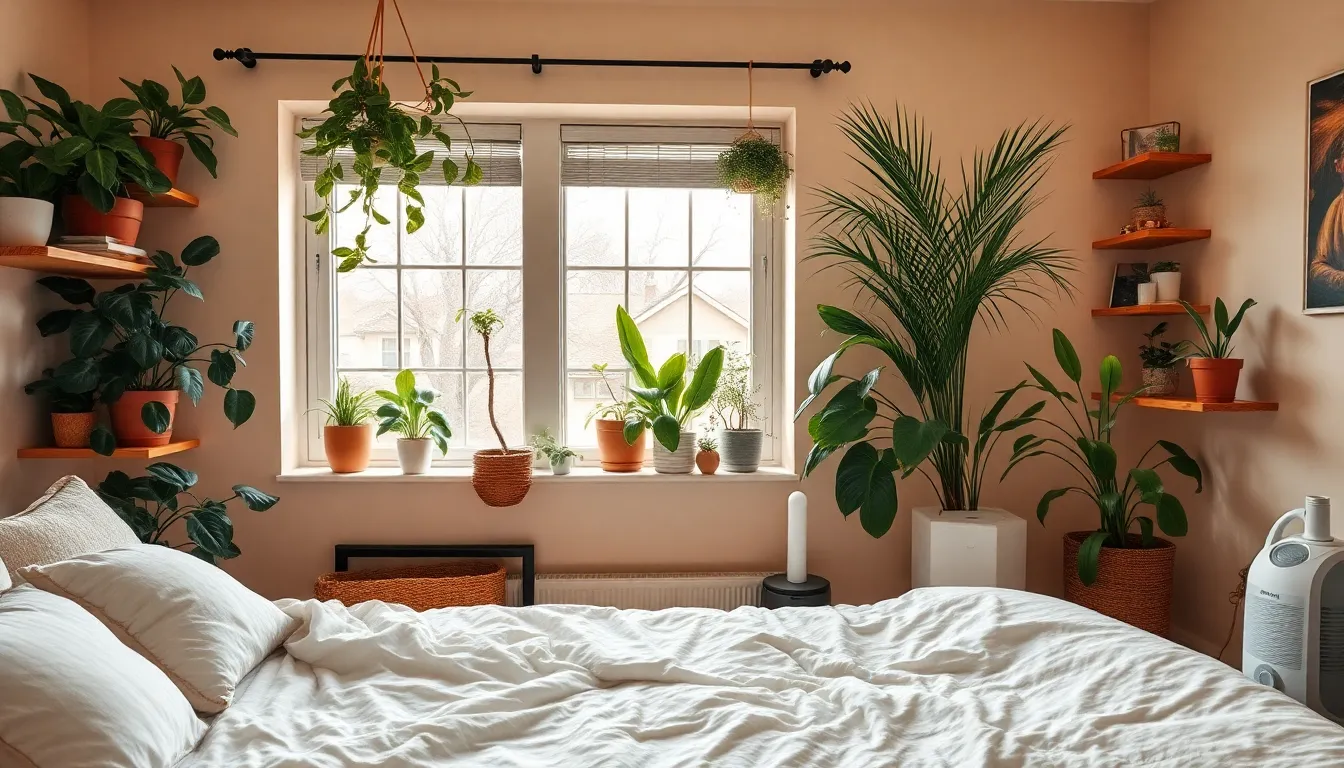
Creating sustainable plant care routines ensures your cozy bedroom sanctuary thrives without overwhelming your daily schedule. We’ll focus on practical maintenance strategies that adapt to your lifestyle while keeping your bedroom plants healthy and vibrant.
Watering Schedules That Work with Your Lifestyle
Matching watering frequency to each plant’s exact needs creates the foundation for successful bedroom plant care. Most bedroom plants like philodendrons prefer evenly moist soil, while succulents such as echeverias need their soil to dry out completely between waterings. We recommend checking soil moisture by inserting your finger one inch deep into the soil before watering.
Observing your plants’ signals helps you adjust watering schedules effectively. Yellowing leaves often indicate overwatering, so we suggest reducing watering frequency when you notice this sign. Creating a simple weekly routine where you check each plant’s soil moisture ensures consistent care without daily worry.
Seasonal adjustments keep your watering schedule realistic throughout the year. Plants typically need more water during spring and summer growth periods, while winter requires less frequent watering as growth slows down.
Humidity Management in Indoor Environments
Maintaining moderate humidity levels benefits most bedroom plants without requiring complex equipment. Many indoor plants like nerve plants thrive with higher humidity, so we recommend occasional misting or using a small humidifier near your plant groupings. This approach creates the ideal growing environment for tropical plants that enhance bedroom coziness.
Selecting plants that tolerate your bedroom’s natural humidity prevents ongoing maintenance issues. Ponytail palms excel in low humidity conditions, making them perfect for drier bedrooms or homes with heating systems that reduce air moisture. We suggest grouping plants with similar humidity needs together to simplify care routines.
Simple humidity boosting techniques integrate seamlessly into bedroom spaces. Placing plants on pebble trays filled with water increases local humidity as the water evaporates, creating a microclimate that supports plant health without affecting your sleeping environment.
Pruning and Maintenance Tips for Healthy Growth
Regular pruning promotes fuller, healthier plant growth while maintaining attractive bedroom aesthetics. We recommend pinching the tips of heartleaf philodendrons to encourage bushier growth and trimming back long stems to prevent plants from becoming leggy. This simple technique keeps plants compact and visually appealing in bedroom settings.
Cleaning plant leaves improves photosynthesis and overall plant health. Dusting leaves occasionally with a soft, damp cloth removes buildup that can block light absorption and reduce your plants’ ability to purify bedroom air effectively.
Strategic repotting and fertilizing support long term plant health without frequent interventions. We suggest using well draining pots to prevent root rot and feeding plants with balanced fertilizer every few months during growing season. Slow growing plants like nerve plants rarely need repotting, making them ideal for low maintenance bedroom gardens.
Style Your Cozy Bedroom with Plants Using Design Principles
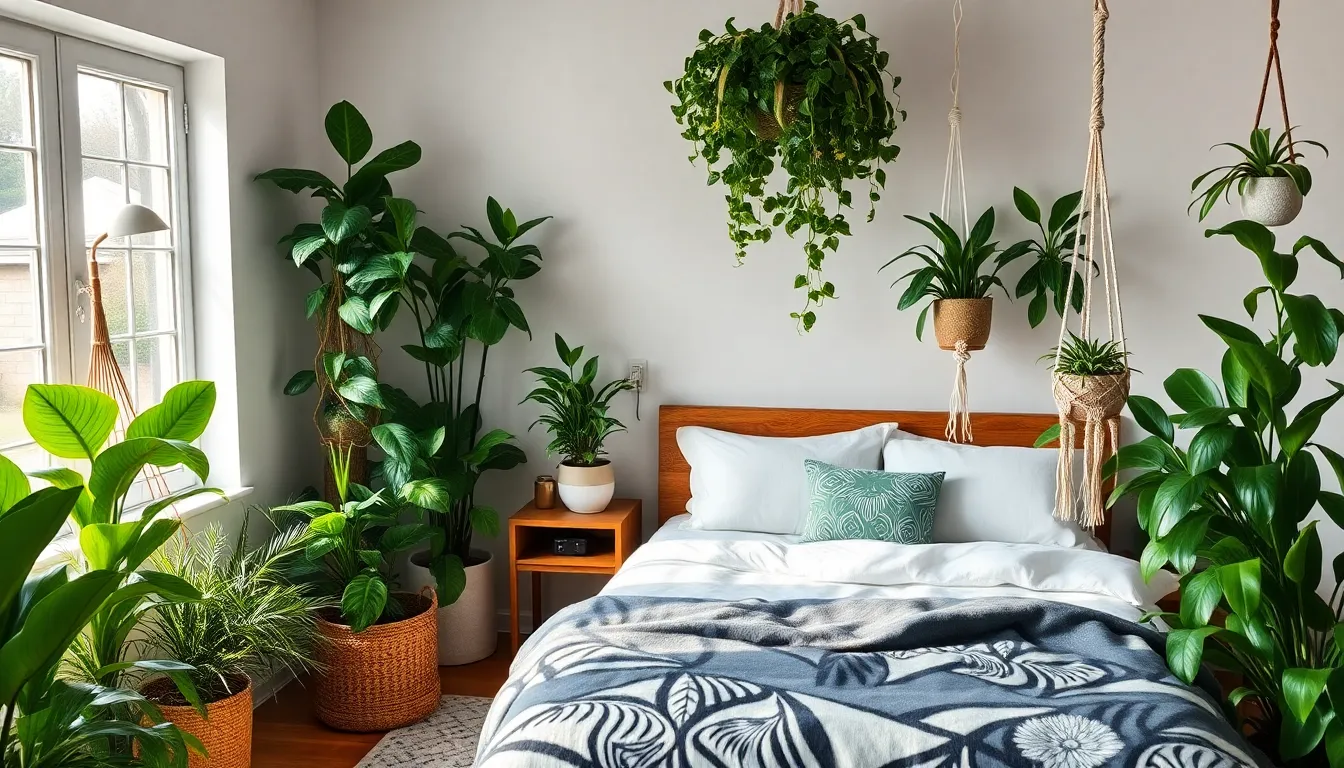
We can transform our bedroom into a harmonious green sanctuary by applying fundamental design principles that treat plants as intentional decor elements. Proportion, balance, and scale work together to create an inviting atmosphere rather than visual clutter.
Creating Visual Balance with Plant Heights
Varying plant heights creates depth and visual interest throughout our cozy bedroom space. Tall plants like the Philodendron Bipinnatifidum anchor corners and provide vertical drama, while medium-height snake plants work perfectly on nightstands or dressers. Small succulents and spider plants positioned on floating shelves or hanging from ceiling hooks add layered dimension to our green oasis.
Hanging gardens offer ever-changing ambiance when we position plants at different heights throughout the room. Trailing pothos cascading from macrame hangers create movement, while sturdy ceiling hooks support heavier plants like Boston ferns. We can achieve professional-looking arrangements by grouping plants in odd numbers and ensuring each level complements the others.
Floor-to-ceiling plant arrangements maximize our bedroom’s vertical space while maintaining cozy proportions. Large floor plants anchor seating areas, tabletop plants provide intimate scale, and hanging varieties draw the eye upward to create an immersive natural environment.
Mixing Textures and Foliage Types
Contrasting foliage textures add visual richness to our bedroom plant collection. Trailing plants like pothos or ivy provide soft, flowing movement that pairs beautifully with the structured geometry of compact succulents. We can create stunning combinations by mixing the long arching leaves of spider plants with the bold, upright forms of snake plants.
Leaf shape variety brings personality to our green bedroom sanctuary. The finger-like edges of Philodendron Bipinnatifidum create dramatic contrast against the pinstriped leaves of Philodendron “Birkin,” while glossy rubber tree leaves provide smooth texture next to the fuzzy surfaces of African violets. We achieve the most impact when we pair at least three different leaf textures in each plant grouping.
Soft textiles complement plant textures to enhance our bedroom’s cozy factor. Plush cushions, woven rugs, and natural fiber throws work harmoniously with varied plant foliage to create layers of tactile interest. We can strengthen this connection by choosing planters with textures that echo our bedding and decor materials.
Incorporating Plants into Existing Bedroom Themes
Color palette coordination ensures seamless integration between our plants and existing bedroom decor. Earthy and natural tones like terracotta, sage green, and warm browns harmonize perfectly with plant greenery while reinforcing our cozy aesthetic. We can tie everything together by selecting planters in colors that already appear in our bedding, artwork, or furniture.
Natural materials strengthen our organic bedroom theme when we choose wood furniture, woven baskets, and stone accents alongside our plant collection. These elements work together to create a cohesive natural environment that feels intentional rather than random. We achieve the strongest impact by repeating materials throughout the space, such as using wooden plant stands that match our bed frame.
Botanical prints and nature-inspired decor echo our plant theme for maximum visual consistency. Wall art featuring leaves or flowers reinforces our green sanctuary concept, while nature photography creates depth and connection to the outdoors. We can assess our lighting conditions to ensure our chosen plants thrive without compromising our carefully planned aesthetic goals.
Maintain Healthy Air Circulation Around Your Plants
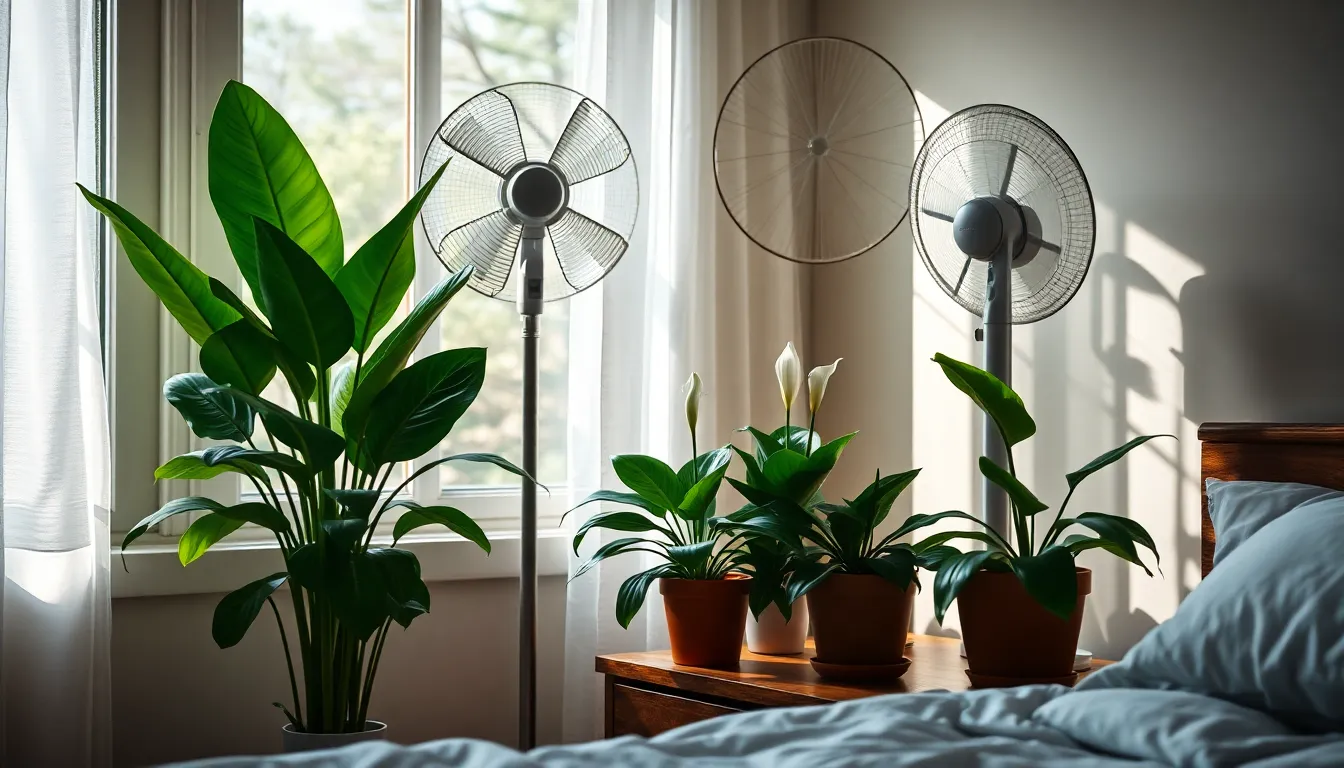
Proper airflow ensures our bedroom plants receive the fresh air they need for cellular respiration through their leaf stomata. We’ll create a healthy environment that benefits both our plants and our sleep quality by implementing strategic circulation methods.
Proper Ventilation Without Compromising Coziness
Oscillating fans positioned quietly in corners promote gentle airflow without disrupting our bedroom’s peaceful atmosphere. We can maintain the cozy feel by choosing fans with silent motors and adjusting them to low speeds that create subtle air movement around our plants.
Opening windows periodically refreshes air quality while preserving the intimate bedroom environment we’ve cultivated. Strategic timing during morning hours or early evening allows fresh air circulation without compromising temperature control or privacy.
Low-light plants like Snake Plants, Peace Lilies, and English Ivy thrive in bedrooms with minimal airflow requirements. These varieties reduce our need for aggressive ventilation while still contributing to improved air quality and humidity regulation.
Preventing Mold and Mildew in Humid Conditions
Drainage holes in our plant containers prevent waterlogged soil that encourages harmful mold and bacteria growth. We’ll select pots with proper drainage systems to protect both plant health and indoor air quality.
Soil moisture levels should remain slightly damp rather than saturated to discourage fungal development. Monitoring our watering schedule prevents overwatering that creates stagnant conditions where mold thrives.
Air movement around plant bases helps prevent the damp, poorly ventilated conditions that support mildew growth. We position plants with adequate spacing between containers to ensure proper airflow reaches all areas of our green sanctuary.
Temperature Control for Both Comfort and Plant Health
Moderate indoor temperatures typical of bedroom settings support most houseplants while maintaining our comfort during rest. We’ll leverage natural air circulation to avoid temperature hotspots that stress both plants and occupants.
Fans assist in maintaining stable temperatures by preventing cold drafts near windows and hot zones near heating sources. Strategic placement creates consistent environmental conditions that support healthy plant growth without disrupting our sleep environment.
Temperature regulation through gentle air movement helps our air-purifying plants like Aloe Vera and English Ivy perform optimally. We create balanced conditions that promote plant vitality while supporting the restful atmosphere we’ve designed for our cozy bedroom retreat.
Conclusion
Creating a plant-filled cozy bedroom doesn’t have to be overwhelming. With the right plant selections proper lighting and thoughtful placement strategies we can transform any bedroom into a peaceful green sanctuary that promotes better sleep and well-being.
The key lies in starting small and building gradually. Choose low-maintenance plants that suit your space and lifestyle then focus on creating the optimal environment for both your plants and your rest. Remember that even a single well-placed plant can make a important difference in your bedroom’s atmosphere.
By treating plants as intentional design elements and establishing simple care routines we’re not just decorating our space – we’re investing in our daily comfort and health. Your cozy plant-filled bedroom awaits and it’s easier to achieve than you might think.
Frequently Asked Questions
What are the best plants for a bedroom sanctuary?
Snake plants, pothos, ZZ plants, and peace lilies are ideal for bedrooms as they thrive in low light conditions and offer air-purifying benefits. These plants require minimal maintenance while contributing to better sleep quality and improved air circulation throughout the night.
How do plants improve bedroom air quality and sleep?
Plants naturally filter toxins from the air and release oxygen, creating a cleaner breathing environment. Spider plants, rubber trees, aloe vera, and Boston ferns are particularly effective at purifying air and maintaining optimal humidity levels, which can lead to more restful sleep.
Where should I place plants in my bedroom for maximum coziness?
Position small to medium plants on bedside tables for intimate nature connection, create corner displays using tiered stands for vertical interest, and utilize hanging plants to save floor space. Group plants with similar lighting needs together for easier care and visual appeal.
What type of lighting do bedroom plants need?
Most bedroom plants prefer bright, indirect sunlight near windows with sheer curtains to diffuse harsh rays. For darker rooms, use LED grow lamps or specialized grow light bulbs with automated timers to provide essential light without disrupting the room’s peaceful atmosphere.
Are there pet-safe plants suitable for bedrooms?
Yes, parlor palms, prayer plants, ponytail palms, and bamboo palms are excellent pet-safe options that maintain air-purifying benefits. These plants create a serene atmosphere while ensuring your furry friends remain safe in the bedroom environment.
How do I maintain proper air circulation for bedroom plants?
Use oscillating fans for gentle airflow and open windows periodically to refresh air quality. Ensure proper drainage in plant containers to prevent mold and monitor soil moisture levels. Strategic fan placement helps maintain stable temperature conditions for both plants and sleep comfort.
What containers work best for bedroom plant decor?
Choose natural materials like terracotta pots and woven baskets to enhance cozy vibes. Coordinate colors with earth tones and neutral containers that complement existing decor. For small spaces, use compact containers on windowsills and bedside tables with vertical hanging options.
How often should I water my bedroom plants?
Watering frequency depends on each plant’s specific needs, room humidity, and season. Most bedroom plants prefer slightly dry soil between waterings. Check soil moisture regularly and establish a consistent schedule, typically watering every 1-2 weeks for most low-maintenance bedroom plants.

